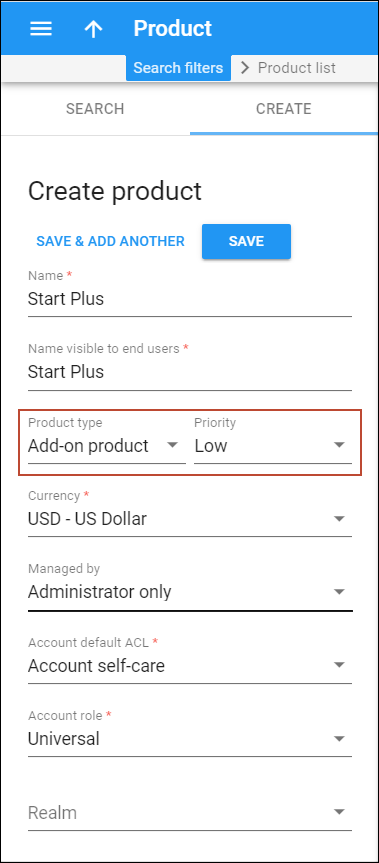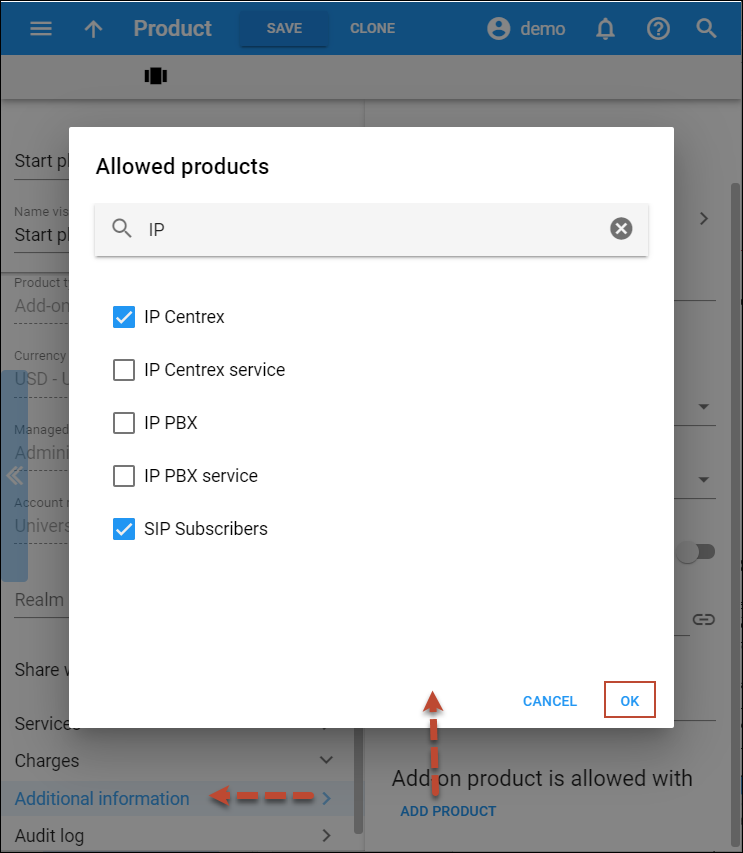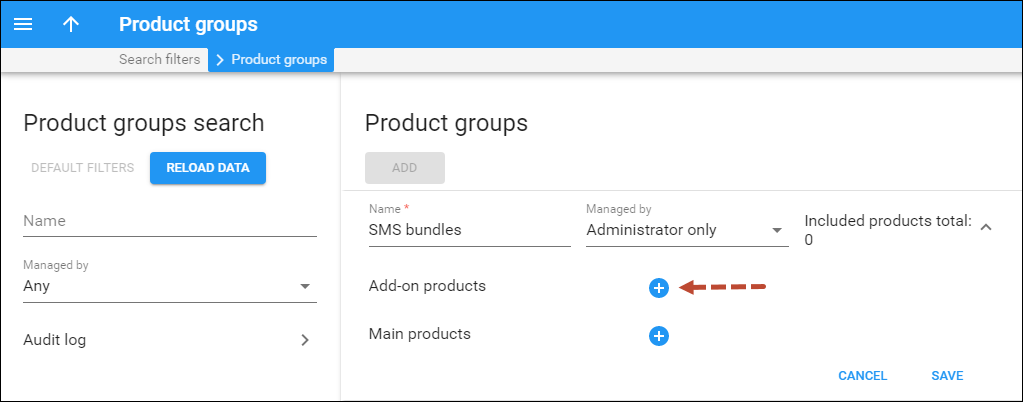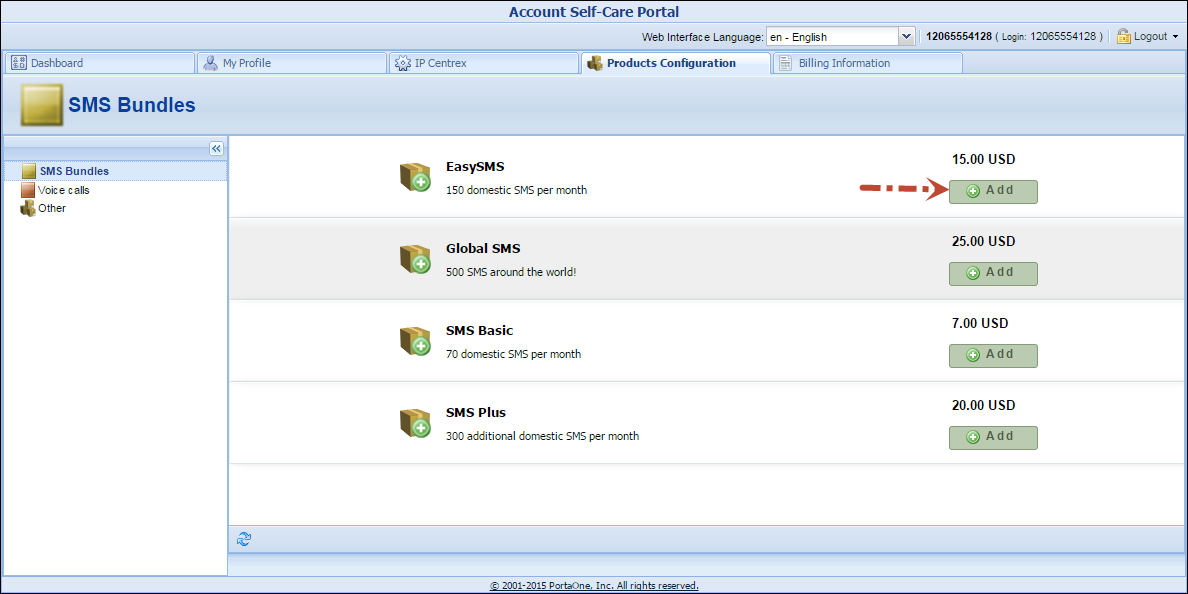General concept of add-on products
Add-on products are a great way to sell additional features/services to your customers and to boost your sales revenue.
Add-on products come with a feature and a subscription attached to them. You only need to assign the add-on product to an account. The feature activates and the customer is automatically charged for it.
Add-on products have the following features:
- Multiple add-on products can be added to an account, creating a desired service configuration.
- Some service features may be defined, so the actual service configuration of an account may have a combination of the service features/attributes of all the products (main and add-ons) and service features/attributes configured on the account directly.
- They may include a definition of extra entries for volume discount plans to be applied to add-on products.
- They often have subscriptions included – so, an account that consumes this add-on product will obligatorily have those subscriptions assigned.
Once a single process for changing a service configuration and applying charges for it is established, there will be an opportunity to:
- Efficiently manage a set of products.
- Avoid revenue leakage (when a service is activated, but a customer is not charged for it).
- Avoid billing disputes (when a customer is charged for a service that was never provisioned).
Add-on products service configuration
Correct service configuration is an important step of product setup since it:
- Ensures that customers are supplied with the quality services that they need.
- Decreases the workload on administrators as it is easier to manage those products in future.
The configuration itself starts from the product, which consists of services consumed by end users. Each service is defined by service type (for example, Voice Calls), which describes the physical service provided to an end user. Every service type consists of service features such as Call waiting, CNAM, etc., which can be activated or deactivated by an administrator. Apart from enabling/disabling for certain features – when they are enabled, additional parameters called “service attributes” must be defined. For example, when the Call via IVR feature is enabled, that’s not enough for that functionality to work properly. Specific IVR applications must also be selected, and these will be used for calls by the end user. These applications should be selected from the Voice Application list on the Outgoing calls configuration panel of the product. In this case, the Voice Application is a service attribute of the Call via IVR functionality.
When configuring services, the services that your customers can use and how they use them can be specified. The service configuration is calculated based on the settings performed within assigned products (main ones and add-on ones).
When configuring add-on products, keep in mind the following peculiarities of the add-on product functionality:
- Priority. Add-on products have priority over main products, so no matter what is defined within the main product it will be overridden by settings defined within the add-on products (this applies only to the options that are supplied with add-on products). In order to differentiate between the add-on products there is also an “override priority” parameter for each add-on product. If more than one add-on product is assigned to an account, they will be sorted according to the
specified priority.
For example, an account with a “Basic Call” main product is assigned a “Smart Call” (low priority level) add-on product with the Conferencing feature disabled. Then the customer decides that he needs the conferencing service, so he orders the “Conferencing+” (high priority level) add-on product with the Conferencing feature enabled. In order for the system to apply the correct values, it weighs the priority level of each add-on product. As a result of service calculation, the conferencing service is enabled for that account.
- Service features. Each add-on product provides only those functionalities that are explicitly defined within its service features. If you need to specify the product default value of a certain feature, move the slider next to the service feature name.
All other service features that are not defined within the add-on product are ignored during the service calculation. In this case, the definition of the feature is taken from another product (in which it is explicitly defined) or from account settings. On the web interface, such service features can be identified by an empty check box on the left of the service feature name (this is the default position of the check box).
- Service Attributes. All attributes can be sorted into three categories:
- Those that are defined on the product level only – they are usually the ones that have some business value and should be controlled by a product.
- Those that are defined for every account separately, e.g., the list of follow-me numbers or the value of “Outgoing CLI” should be defined for each account individually.
- Those that can be defined on both product and account levels. For example, the maximum number of forwarded calls is normally defined on the product level, so residential customers have it set to 3, and PBX customers to 10. However, for some accounts, it may be set to a higher value (for example, there are 12 people in the customer’s sales department and the customer wants to forward calls to all of them).
Note that a service feature that is defined on the account level overrides the one provided by the product.
- Product compatibility. Every add-on product has a list of allowed main products with which this add-on product is compatible and with which it can be assigned to an account.For example, the main product “EasyCall” only has basic and inexpensive services. Of course, every customer can order additional features, but to do this, the main product must be upgraded to an advanced version – for example, the “Smart Call” product, with which additional services “a la carte” can easily be assigned. In this case, all add-on products will have the “Smart Call” product allowed.
- Service features conflict. A situation where the same service feature is set by different add-on products with the same priority level cannot occur. The system does not allow such configurations to be saved and will notify an administrator concerning which features and add-on products caused the conflict. For example, an administrator tries to apply the “Unconditional forwarding” add-on product with Call Waiting functionality disabled and the “Advanced forwarding” add-on product which has Call Waiting functionality enabled. Both add-on products have the same priority level, so saving this configuration will not be allowed since it is unclear whether the Call Waiting functionality should be enabled or disabled.
Product groups
When you provide various add-on products and allow end users to sign up for add-ons via the account self-care portal, you may also want to provide them with effective product management tools.
This can be done by organizing your add-on products in groups. Now administrators or resellers can create product groups and assign corresponding add-ons to them via the admin interface/reseller’s self-care.
Then these groups are available to end users on the Products Configuration tab of the account self-care interface. A user can easily find a desired add-on by entering the corresponding group that the add-on belongs to.
Consider the following example:
Customer John Doe has 50 free domestic SMS and 100 free minutes of calls to US and Canada destinations included in his main product. He wants to increase the number of domestic SMS to 200 and add 200 free minutes of calls to Brazil.
He visits his account self-care interface and goes to the Product Configuration tab. He selects the SMS Bundles group, finds the “Easy SMS” add-on product that provides 150 domestic SMS messages and signs up for it.
Then he selects the Voice calls group and signs up for the '”Carnival 200” add-on product that provides 200 free minutes of calls to Brazil.
Now John Doe has his desired product configuration and can further enjoy its services.
Thus, product groups enable end users to perform a quick and easy product search and self signup, thereby decreasing the load for your administrators and customer care staff.









